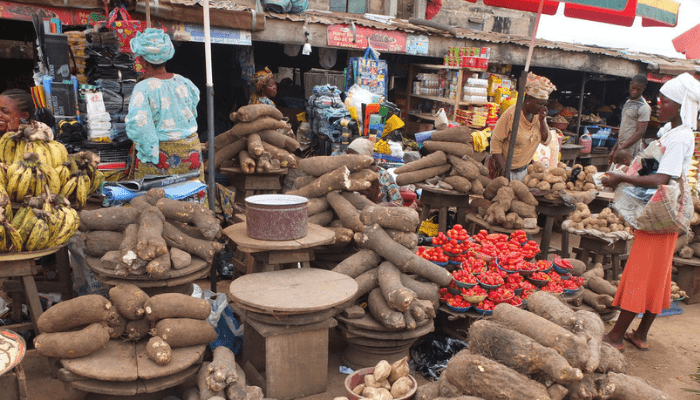Farmers’ push for higher profits in urban markets is stoking inflation in interior communities, widening the price gap between cities and rural areas, experts have said.
Latest Consumer Price Index data put urban inflation at 15.65 percent in October, marking a 0.21 percentage point below the 15.86 percent recorded in rural areas. This was the third consecutive rise since August.
In August and September, urban inflation stood at 19.75 and 17.50 percent, while rural inflation readings were 20.28 and 18.26 percent, respectively.
Read also: FG mobilises 80,000 farmers for ₦160bn wheat production push
Experts attribute the trend to farmers and traders moving produce to urban centres where markets are more reliable and profitable.
Muda Yusuf, director and CEO of the Centre for the Promotion of Private Enterprise (CPPE), attributed the trend to the reliability of markets in cities, which often prompt farmers and traders to move food products to cities rather than rural areas.
“Most of the crops grown in the rural areas are all supplied to the cities because of the reliable markets, leaving very little for nearby markets. This creates artificial scarcity and makes prices higher than in urban centres,” he said.
He also said that the rising insecurity is hitting rural communities harder, restricting movement of goods and further raising costs.
Food inflation has been the major driver of headline inflation in Africa’s most populous nation, according to the National Bureau of Statistics (NBS).
Why the trend persists
Abiodun Olorundenro, founder and managing partner of Prasinos Farms, said that food supply is usually higher in the urban centres than in rural areas as they offer guaranteed markets for farmers and traders.
“Owing to the chase for profits, traders now buy directly from the farm’s harvest and move them to markets in urban centres, leaving limited supply to local markets there,” he said.
“This makes the few ones available to cost higher,” he noted, while also highlighting the impact of insecurity in driving inflation in rural communities.
Insecurity, which is a long drag on Nigeria’s economy, is intensifying across key regions. In the North, jihadist groups continue to target rural communities and, in the South-East, separatist agitations have disrupted transport and trade. Meanwhile, banditry and kidnappings for ransom have become rampant in central states.
“My mother-in-law visited me recently and bought food items from Lagos to the village owing to higher rural food prices,” said an analyst, who does not want to be quoted.
Read also: Two farmers killed, four abducted as fresh attack hits Kwara community
“This is because prices in rural communities are higher, and I think this is why the inflation rate is higher in those areas than in the cities,” she added.
Charles Anudu, founding managing director, Candel Company Limited, cited higher transportation costs, less competition among local businesses and the unique expenses of rural life as contributors.
FX stability and naira appreciation are also playing a role. Yusuf explained that the benefits of naira strengthening are felt first in cities, where more imported goods are consumed.
Yusuf noted that the economics of international trade favours cities more than rural centres.
“Our ports, where the goods are imported from, are located in major cities and this makes the naira appreciation impact to be felt faster in the urban centres than rural communities,’ Yusuf said.
Also, Tajudeen Ibrahim, director of research and strategy at Chapel Hill Denham, referenced the country’s foreign exchange (FX) stability and naira appreciation against the dollar as the main drivers of lower inflation rate in urban areas.
“Most of the things people in the urban centres spend more on are dollar-dominated items, unlike the demand element found in the rural areas,” Ibrahim explained.
“With the FX stability and naira appreciation, inflation tends to fall faster in urban centres than rural areas,” he noted.
FX reforms
A series of far-reaching policy reforms by the Central Bank of Nigeria (CBN) has diversified the country’s FX sources and brought some stability.
The ease of FX market pressure since the beginning of the year has signalled a recovery of an economy previously burdened by currency-induced risks.
Also, the naira has continued to appreciate against the dollar, exchanging 1,465/$ on Wednesday at the parallel market as against 1,620/$ in January.
A recent report by United Capital Plc noted that the naira experienced a significant strengthening in October 2025.
According to the report, the average exchange rate appreciated by 2.62 percent, moving from N1,497/$ in September to N1,459/$ in October.
The currency closed October at N1,421/$, an improvement from N1,475/$ recorded at the end of September.
United Capital attributed this positive performance to growing investor confidence, increased FX inflows, and a favourable trade balance driven by declining imports and rising exports.
Read also: Minister hails Kaduna agro-investments, assures farmers of support
Ayo Teriba, an economist and the CEO of Economic Associates, said the higher rural inflation versus urban inflation is fuelled by devaluation.
“As the exchange rate appreciates, the impact on the prices of imported goods and services is felt faster than that of the local items,” he said, noting that urban centres consume more imported products and experience the impact more quickly than rural areas.









